#ancient artifacts
Explore tagged Tumblr posts
Text

Archeologists Discover 2,500-Year-Old Midas Dynasty Tomb in Turkey
A 2,500-year-old royal tomb has been discovered by archeologists at the site of an ancient city in Turkey.
After four months of excavations, Penn Museum and Ankara Hacı Bayram Veli University archeologists discovered a well-preserved royal tomb chamber that dates back to 8th century BCE (800 to 701 BCE). The tomb's roof was collapsed, but objects inside remained intact, including bronze vessels used during banquets, iron rods, a pair of large bronze cauldrons and assorted smaller bronze cauldrons, jugs and bowls, according to a news release.
The tomb was discovered at the archeological site of Gordion, the capital of the Phrygian kingdom, which controlled much of Asia Minor during the first millennium BCE, Gordion Excavation Director C. Brian Rose said in a news release. Gordion is located in northwest Turkey, about 60 miles southwest of Turkey’s capital Ankara.




At one time, Gordion was ruled by King Midas, famously known for his "golden touch." Archeologists believe that the newly-discovered tomb may have belonged to a member of the Midas dynasty.
Archeologists used magnetic prospection technology to find the tomb, a news release states. This geophysical method uses variations in Earth’s magnetic field to identify objects below the surface, according to the U.S. Environmental Protection Agency.
to archeologists’ surprise, the tomb indicated a cremated burial. Up until this latest excavation, researchers believed the first cremation to occur in Gordion was more than 100 years later.
Vessels inside the tomb also featured textiles adhered to their exterior, which indicate that textiles were an important industry in Gordion, Rose said in a news release.
The tomb was located near and appeared like the Midas Mound tomb, which is believed to have housed the body of King Midas’ father.
The Gordion site has proved fruitful for archeologists for 75 years, since Penn Museum began leading excavations there in 1950. Previous excavations included the oldest wooden building in the world, dating back to 740 BCE. Others include the earliest colored stone mosaics found in Gordion, the best-preserved citadel gate of the first millennium and a gilded ivory sphinx of the 6th century BCE, according to a news release.
By Greta Cross.




#Archeologists Discover 2500-Year-Old Midas Dynasty Tomb in Turkey#King Midas#Gordion#Phrygian kingdom#ancient tomb#ancient grave#funeral goods#ancient artifacts#archeology#history#history news#ancient history#ancient culture#ancient civilizations
86 notes
·
View notes
Text
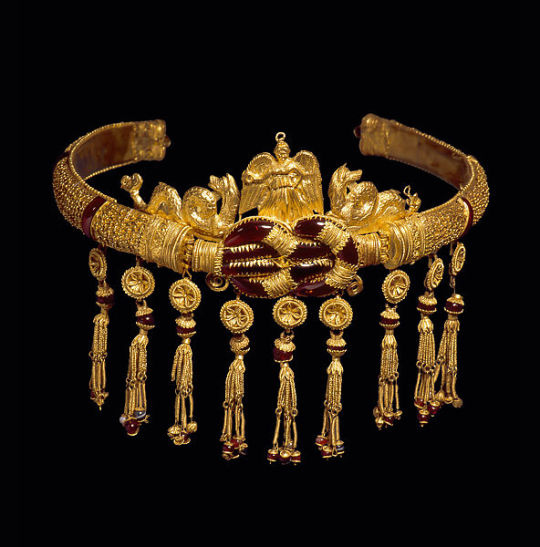
Greek Gold diadem with Hercules knot (250–150 BCE),
Gold, garnet, carnelian, sardonyx
3×9 1/8 in. (7.6 × 23.1 cm).
On loan to the Metropolitan Museum.
#greek art#ancient artifacts#ancient art#antiquities#antiquity#jewellery#archeology#met museum#art history#history#garnet#carnelian#sardonyx#heracles#hercules
3K notes
·
View notes
Text




Roman-Christian vandalism of Greek & Roman statues
in early 4th century AD, with emperor constantine's conversion to christianity, and the edict of milan (which gave freedom of religion to roman citizens, and legalised christianity) christianity had begun to overtake rome. under Constantine’s reign the suppression of paganism began, pagan places of worship lost funding, some were repurposed for christian use and some were destroyed. Constantine and his successors authorised and encouraged the burning of pagan books and the destruction and defacement of pagan temples, statues, sacred sites, art works, and anything else they believed was ‘challenging christianity’. By the late 4th century christianity had overtaken Rome, and polytheistic religion was a thing of the past.
1. defaced statue of unknown goddess, 2nd - 1st century BC, Archaeological Museum of Samos 2. bust of roman general, Germanicus, 14-20 CE, the British Museum 3. head of Aphrodite, 1st century AD, National Archaeological Museum of Athens 4. bust of Emperor Augustus, n.d, the Ephesus Museum
#ancient rome#roman empire#ancient#4th century AD#collections#archiveofmyown#statue#roman religion#roman polytheism#emperor constantine#artefact#archaeology#ancient artifacts#ancient world#classics#classical word#classical civilization
278 notes
·
View notes
Text

Octopus vase from Palaikastro
c. 1500 BCE, painted stone
#ancient artifacts#ancient art#octopus#nature#wildlife#sea life#antiquities#ancient people#ancient culture#vessel#aesthetic#beauty#modern art#art history#aesthetictumblr#tumblraesthetic#tumblrpic#tumblrpictures#tumblr art#tumblrstyle#artists on tumblr
2K notes
·
View notes
Text
beautiful things
Egyptian craftsmen;
Scarab Bracelet of Tutankhamun, made of (gold, lapis-lazuli, carnelian, turquoise, colored glass), (c.1567-1320 BC), Tomb of Tutankhamun, Valley of the Kings, West Thebes.

96 notes
·
View notes
Text
Akhnatens letters

*These are five of the Amarna letters in the british museum
The Amarna letters features letters directed to Akhnaten and before him his father about the fall of conquered terratories in Caanan and Syria to the kingdoms of the Mitanni, the Babylonians and the Hittites.
These letters are featured in the opera Akhnaten in the third act and are transcribed from Samuel A.B Mercers translation from his 1939 book "Mercer, The Tel-el-Amarna Tablets". The book is hard to find so I cannot connect the letters to their correct tablets at this time but I will when I get ahold of the book.
The letters are used to paint a good picture of the severe losses Egypt suffered during Akhnaten and his ancestors reign. His descendants in the 18th dynasty mitigated the issue but the 19th dynasty namely Seti I and Ramesses II probably reclaimed the most.
Letter No. 1: I have written repeatedly for troops, but they were not given and the king did not listen to the word of his servant. And I sent my messenger to the palace, but he returned empty-handed - he brought no troops. And when the people of my house saw this, they rediculed me like the governors, my brethren, and dispised me.
Letter No. 2: The king's whole land, which has begun hostilities with me, will be lost. Behold the territory of Seir, as far as Carmel; its princes are wholly lost; and hostilities prevail against me. As long as ships were upon the sea the strong arm of the king occupied Naharin and Kash, but now the Apiru are occupying the king's cities. There remains not one prince to my lord, the king; every one is ruined. Let the king take care of his land and let him send troops. For if no troops come in this year, the whole territory of my lord, the king, will perish. If there are no troops in this year, let the king send his officer to fetch me and his brothers, that we may die with our lord, the king.
Note: Naharin meant the land of the Mitanni claimed by Thutmose III in his military campaign.
Letter No. 3: Verily, they father did not march forth nor inspect the lands of the vassal-princes. And when thou ascended the throne of thy father's house, Abdashirta's sons took the king's lands for themselves. Creatures of the king of Mittani are they, and of the king of Babylon and of the king of the Hittites.
Letter No. 4 Who formerly could have plundered Tunip without being plundered by Thutmose III? The gods of the king of Egypt, my lord, dwell in Tunip. May my lord ask his old men if this not be so. Now, however, we belong no more to our lord, the king of Egypt. And now Tunip, thy city, weeps and her tears are flowing and there is not help for us. For twenty years we have been sending to our lord, the king of Egypt, but there has not come to us a word - no, not one.
#egyptology#ancient artifacts#hittite empire#ancient civilizations#ancient world#antiquity#archeology#ancient history#ancient artefacts#artefact#akhenaten#opera#philip glass#bronze age#mitanni#egypt#ancient egypt#egyptian history#egyptian#ancient#akhnaten
120 notes
·
View notes
Text
Witness to a Tragedy: The Discovery of the Polyxena Sarcophagus
In 1994, during a rescue excavation at the Kızöldün Tumulus near Biga in Çanakkale Province, Türkiye, archaeologists unearthed a remarkable artifact: the Polyxena Sarcophagus.
Dating back to approximately 520–500 BCE, this marble sarcophagus is considered the earliest known example in Anatolia featuring figural reliefs.
The sarcophagus is adorned with intricate carvings depicting scenes from the life and tragic death of Polyxena, the youngest daughter of King Priam and Queen Hecuba of Troy.
One side illustrates her sacrifice by Neoptolemos, son of Achilles, at the tomb of his father — a poignant moment rooted in Greek mythology.
Another panel portrays Queen Hecuba mourning beneath a barren tree, while additional sides show ceremonial processions with musicians and dancers.
Interestingly, despite the sarcophagus's association with Polyxena, it contained the remains of a 40-year-old man, suggesting it may have served a symbolic or commemorative purpose rather than being her actual tomb.
Today, the Polyxena Sarcophagus is prominently displayed at the Troy Museum in Tevfikiye village, near the ancient city of Troy.
The museum, inaugurated in 2018, houses over 2,000 artifacts that chronicle the rich history of the region.
In a contemporary reflection on the themes depicted, the museum covered the sarcophagus with a black cloth on 25 November 2024 to mark the International Day for the Elimination of Violence Against Women.
This act aimed to highlight the enduring issue of violence against women, connecting ancient narratives to present-day concerns.
#Polyxena Sarcophagus#Kızöldün Tumulus#Biga#Çanakkale Province#Türkiye#archaeology#artifact#Anatolia#figurial reliefs#marble sarcophagus#sarcophagus#Polyxena#King Priam#Queen Hecuba of Troy#Neoptolemos#Achilles#greek mythology#Troy Museum#Troy#International Day for the Elimination of Violence Against Women#ancient civilizations#ancient artifacts
90 notes
·
View notes
Note
Do we know anything about dwarven technology and/or magic? They are said to have the lowest magical potential, but I remember a picture of dwaves using a stationary phone of some kind and it seemed like there was an undine in one of the mechanisms and a dwarf having ancient magic markings in daydream portraits. They seem to have a lot of technology and magic things going on, but I can't find any info on it.
We only see a little bit of it, I was also wondering about what seems like magic tattoos in the dwarf page, perhaps is another type of tattoo instead? Or maybe it has to do with why that dwarf has a strange look on his face

The other one with similar head tattoos has half of his body burnt

Could be a warrior thing? I don't think it's the same as the magic ones, they canonically have the lowest mana reserve so I doubt they can use much magic if at all?
The tech they use seem to have to do with the ancient war when apparently there was a tech boom, but most of it apparently was buried along with dungeons.


We only see these important guys messing with something similar

226 notes
·
View notes
Text
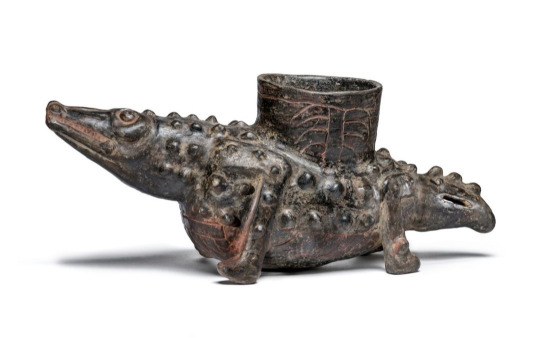
Mayan croc vessel, Mexico AD 300-600, Los Angeles Country Museum of Art
417 notes
·
View notes
Text

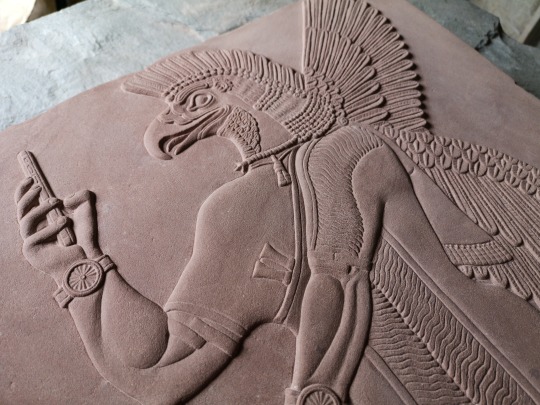

Out of place artifact.
Hand carved sandstone, based on an ancient Assyrian Winged Genie, but with a twist.
#carving#stone carving#art#traditional art#sculpture#assyrian#ancient history#archeology#history#ancient artifacts#mesopotamian art#mesopotamia#mesopotamian#genie#ancient art#ancientmonuments#antiquities#neoassyrian
536 notes
·
View notes
Text
youtube
Credit Card Imprinters --- How were credit card payments made before instant electronic point of sale?
from Payment Village
28 notes
·
View notes
Text

One of a Kind 7th Century Gold Coin Found in UK
A tiny gold coin that is believed to be the oldest from the Anglo-Saxons in East Anglia has been found in a field.
Coin expert Adrian Marsden described the coin as a "massively significant" find that was struck in the 7th Century.
The design depicts a man dancing a jig while holding a Christian cross above a symbol linked to the Norse god Odin.
The coin was discovered by a metal detectorist near Norwich in the autumn and Norwich Castle Museum hopes to acquire it.
"It's the first one of this type of coin that we've seen and new types of shillings just don't turn up," said Dr Marsden, from the Norfolk Historic Environment Service.
"It's got this fascinating iconography of a little figure with a long cross - explicitly Christian - over the valknut design, which has pagan roots."
Dr Marsden said all the evidence pointed to it being "the earliest Anglo-Saxon East Anglian coin so far known", dating it to AD640 to 660.
It was struck at a time when pagan beliefs were starting to give way to Christianity, and its design appears to straddle this time of change.

Experts associate the design with the god Odin, whose roles in Norse mythology included ferrying the dead to the afterlife.
In the 20th Century, the valknut was adopted as a symbol by white supremacists among others.
The coin dates back to the same era as the famous Sutton Hoo ship burial, which, as Dr Marsden explained, had a mix of Christian and pagan grave goods.
On the reverse of the coin is a design that could be a cross or could be a swastika, then recognised as a good luck symbol, surrounded by an attempt at a Latin inscription.
Dr Marsden recently published his research in the Searcher.
"It's plain from looking at the letters that whoever made the die wasn't literate, the letters don't bear much resemblance to Latin - they're garbage really," he explained.
Testing revealed the coin was made from a very high gold content, of up to 60%.
Dr Marsden also pointed out it was the second coin in Norfolk to benefit from a new treasure definition on "the basis of national significance".
The government changed the legal definition of the 1996 Treasure Act two years ago, to try getting more artefacts on public display.
A coroner decides if a discovery is treasure and a museum usually gets first refusal over whether to store it.
By Katy Prickett.

#One of a Kind 7th Century Gold Coin Found in UK#Norwich#gold#gold coins#collectable coins#metal detecting#ancient artifacts#archeology#history#history news#ancient history#ancient culture#ancient civilizations#anglo saxon#ancient art
31 notes
·
View notes
Text
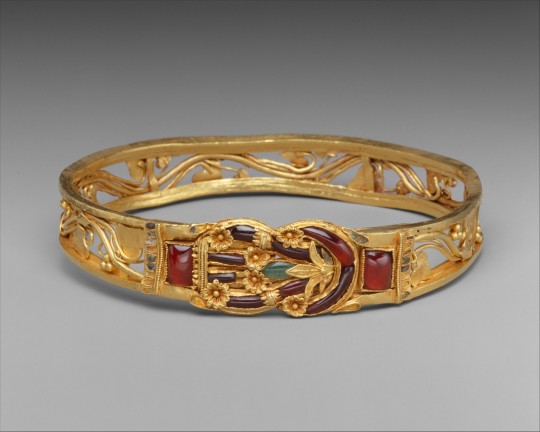
Gold armband with Herakles knot
Hellenistic period
3rd–2nd century BCE
Gold inlaid with garnets, emeralds, and enamel
3 1/2in. (8.9cm)
The Herakles knot on this sumptuous armband is enriched with floral decoration and inlaid with garnets, emeralds, and enamel. According to the Roman writer Pliny, the decorative device of the Herakles knot could cure wounds, and its popularity in Hellenistic jewelry suggests that it was thought to have the power to avert evil.
from The Metropolitan Museum of Art, New York
#greek art#hellenistic art#ancient artifacts#ancient art#antiquities#art history#archeology#hercules#carnelian#met museum#herakles
684 notes
·
View notes
Text
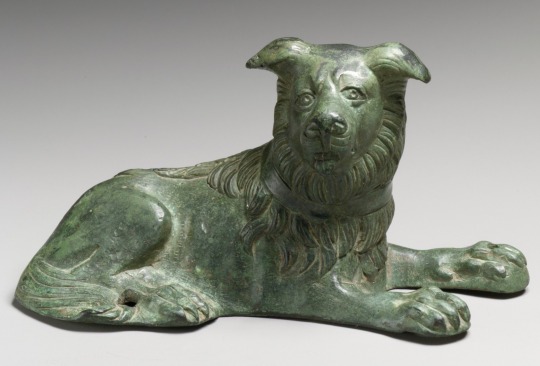
Bronze statuette of a dog
Roman
2nd-3rd century CE
#roman art#dogs#bronze#bronze statue#animals in art#ancient art#ancient people#ancient statue#statue aesthetic#aesthetic#beauty#ancient artifacts#artifacts#antiquities#beautiful animals#dogs of tumblr#cute dogs#modern art#art history#aesthetictumblr#tumblraesthetic#tumblrpic#tumblrpictures#tumblr art#tumblrstyle#artists on tumblr
2K notes
·
View notes
Text








this is also a png blog now. carved artifacts from the Penn Museum.
#photography#iphone photography#transparent#png#ancient art#ancient artifacts#penn museum#philadelphia#pngs#transparent png#aesthetic pngs#carving#stone carvings#history#art history
24 notes
·
View notes
Text

A Hittite cuneiform tablet declaring the first surviving recorded peace treaty in history between Ramesses II and Ḫattušili III respectivly rulers of the New Kingdom of Egypt and the empire of the Hittites. The tablet is written in the Hittite language and their cuneiform.
This is one of three known relics of the treaty. Also known as The Treaty of Kadesh.
Circa 1259 BC
The tabelt is displayed at the Museum of the Ancient Orient in Turkey
#egyptology#ancient civilizations#ancient world#antiquity#archeology#ancient history#egyptian history#ancient egypt#hittite empire#hittite#archaeology#artifacts#cuneiform#anatolia#mesopotamia#artifact#ancient artifacts
86 notes
·
View notes